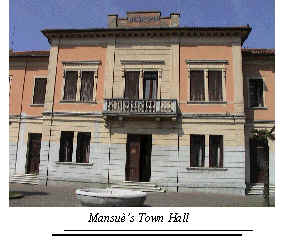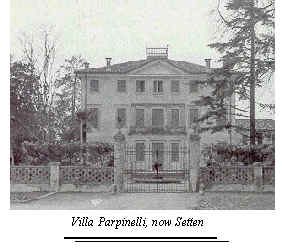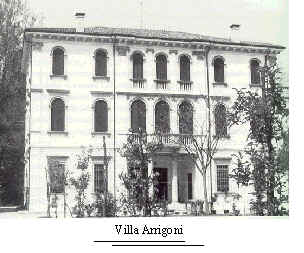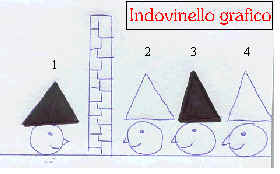|




| |
 |
|
 Mansuč
is situated in the north-east of Italy, in a region called Veneto. It’s at
seventy kilometres from Venice. It’s a small town with a population of
about four thousand inhabitants. It’s in the countryside, on the river
Livenza. It’is not a very important historical town, yet its origins go
back to the Romans. In that period Mansuč was a mansio, that is a
small village set near a river or a road which connected important
towns; it was a place where people travelling could stop for a rest or to eat
as well as to buy or to rent a horse. The name of the town seems to come from
the word mansio. You can see some relics of that period at the Museo Civico
‘Eno Bellis’ in Oderzo, a town at about three Mansuč
is situated in the north-east of Italy, in a region called Veneto. It’s at
seventy kilometres from Venice. It’s a small town with a population of
about four thousand inhabitants. It’s in the countryside, on the river
Livenza. It’is not a very important historical town, yet its origins go
back to the Romans. In that period Mansuč was a mansio, that is a
small village set near a river or a road which connected important
towns; it was a place where people travelling could stop for a rest or to eat
as well as to buy or to rent a horse. The name of the town seems to come from
the word mansio. You can see some relics of that period at the Museo Civico
‘Eno Bellis’ in Oderzo, a town at about three  kilometres
from Mansuč. Nowadays in Mansuč you can visit the old church and some
ancient but very beautiful mansions, for example Villa Aganoor now Arrigoni,
Villa Soldi-Cadorin, Villa Calzavarra, Villa Parpinelli now Setten and Villa
Carretta. Not far from Mansuč, on the way to Pordenone, there’s a very
nice small village kilometres
from Mansuč. Nowadays in Mansuč you can visit the old church and some
ancient but very beautiful mansions, for example Villa Aganoor now Arrigoni,
Villa Soldi-Cadorin, Villa Calzavarra, Villa Parpinelli now Setten and Villa
Carretta. Not far from Mansuč, on the way to Pordenone, there’s a very
nice small village called Portobuffolč. Its historical centre has a lot of ancient buildings
which bear witness to the important past of this borough. During the Republic
of Venice Portobuffolč was an important fluvial port dealing especially with
salt. Mansuč is above all an agricultural town yet there are a lot of
industries, furniture-production and plastic-production industries. In our
opinion Mansuč is a nice town where to live. There are lots of facilities,
there are a nursery school, a primary school and a ‘scuola media’.
Besides you can find a library, many shops, some supermarkets, some banks
some restaurants and some pizza houses. If you like sports there is a
gymnasium, a football ground, some basketball grounds, a volleyball ground, a
beach-volley ground and a skating rink.
called Portobuffolč. Its historical centre has a lot of ancient buildings
which bear witness to the important past of this borough. During the Republic
of Venice Portobuffolč was an important fluvial port dealing especially with
salt. Mansuč is above all an agricultural town yet there are a lot of
industries, furniture-production and plastic-production industries. In our
opinion Mansuč is a nice town where to live. There are lots of facilities,
there are a nursery school, a primary school and a ‘scuola media’.
Besides you can find a library, many shops, some supermarkets, some banks
some restaurants and some pizza houses. If you like sports there is a
gymnasium, a football ground, some basketball grounds, a volleyball ground, a
beach-volley ground and a skating rink.
 Elena,
Tosca and Diana (3^ I) Elena,
Tosca and Diana (3^ I)
|
|
 Ci
sono quattro condannati a morte che vengono sotterrati fino alla testa cosě
come appare nel disegno dove si puň vedere che uno di loro guarda un muro
mentre gli altri sono posizionati in fila, uno dietro all’altro. A ciascuno
viene messo un cappello: due cappelli sono bianchi e due sono neri, ma
nessuno conosce il colore del proprio cappello. Ai condannati viene detto che
uno solo di loro puň salvarsi: quello che con assoluta certezza puň dire di
che colore ha il cappello. Attenzione, i condannati non si possono parlare!
Chi si salverŕ? Ci
sono quattro condannati a morte che vengono sotterrati fino alla testa cosě
come appare nel disegno dove si puň vedere che uno di loro guarda un muro
mentre gli altri sono posizionati in fila, uno dietro all’altro. A ciascuno
viene messo un cappello: due cappelli sono bianchi e due sono neri, ma
nessuno conosce il colore del proprio cappello. Ai condannati viene detto che
uno solo di loro puň salvarsi: quello che con assoluta certezza puň dire di
che colore ha il cappello. Attenzione, i condannati non si possono parlare!
Chi si salverŕ?
by Enrica (2^ G) |
|
